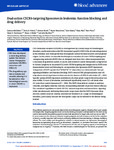Dual-action CXCR4-targeting liposomes in leukemia: function blocking and drug delivery
| dc.contributor.author | McCallion, C | |
| dc.contributor.author | Peters, AD | |
| dc.contributor.author | Booth, A | |
| dc.contributor.author | Rees-Unwin, K | |
| dc.contributor.author | Adams, J | |
| dc.contributor.author | Rahi, R | |
| dc.contributor.author | Pluen, A | |
| dc.contributor.author | Hutchinson, Claire | |
| dc.contributor.author | Webb, SJ | |
| dc.contributor.author | Burthem, J | |
| dc.date.accessioned | 2019-10-01T08:51:53Z | |
| dc.date.issued | 2019-07-23 | |
| dc.identifier.issn | 2473-9529 | |
| dc.identifier.issn | 2473-9537 | |
| dc.identifier.uri | http://hdl.handle.net/10026.1/14951 | |
| dc.description.abstract |
<jats:title>Abstract</jats:title> <jats:p>CXC chemokine receptor 4 (CXCR4) is overexpressed by a broad range of hematological disorders, and its interaction with CXC chemokine ligand 12 (CXCL12) is of central importance in the retention and chemoprotection of neoplastic cells in the bone marrow and lymphoid organs. In this article, we describe the biological evaluation of a new CXCR4-targeting and -antagonizing molecule (BAT1) that we designed and show that, when incorporated into a liposomal drug delivery system, it can be used to deliver cancer therapeutics at high levels to chronic lymphocytic leukemia (CLL) cells. CXCR4 targeting and antagonism by BAT1 were demonstrated alone and following its incorporation into liposomes (BAT1-liposomes). Antagonism of BAT1 against the CXCR4/CXCL12 interaction was demonstrated through signaling inhibition and function blocking: BAT1 reduced ERK phosphorylation and cell migration to levels equivalent to those seen in the absence of CXCL12 stimulation (P &lt; .001). Specific uptake of BAT1-liposomes and delivery of a therapeutic cargo to the cell nucleus was seen within 3 hours of incubation and induced significantly more CLL cell death after 24 hours than control liposomes (P = .004). The BAT1 drug-delivery system is modular, versatile, and highly clinically relevant, incorporating elements of proven clinical efficacy. The combined capabilities to block CXCL12-induced migration and intracellular signaling while simultaneously delivering therapeutic cargo mean that the BAT1-liposome drug-delivery system could be a timely and relevant treatment of a range of hematological disorders, particularly because the therapeutic cargo can be tailored to the disease being treated.</jats:p> | |
| dc.format.extent | 2069-2081 | |
| dc.format.medium | ||
| dc.language | en | |
| dc.language.iso | en | |
| dc.publisher | American Society of Hematology | |
| dc.subject | Antineoplastic Agents | |
| dc.subject | Cell Survival | |
| dc.subject | Chemokine CXCL12 | |
| dc.subject | DEAD-box RNA Helicases | |
| dc.subject | Doxorubicin | |
| dc.subject | Drug Carriers | |
| dc.subject | Drug Delivery Systems | |
| dc.subject | Humans | |
| dc.subject | Leukemia | |
| dc.subject | Leukemia, Lymphocytic, Chronic, B-Cell | |
| dc.subject | Liposomes | |
| dc.subject | Lymphocytes | |
| dc.subject | Molecular Structure | |
| dc.subject | Molecular Targeted Therapy | |
| dc.subject | Protein Binding | |
| dc.subject | Receptors, CXCR4 | |
| dc.title | Dual-action CXCR4-targeting liposomes in leukemia: function blocking and drug delivery | |
| dc.type | journal-article | |
| dc.type | Journal Article | |
| dc.type | Research Support, Non-U.S. Gov't | |
| plymouth.author-url | https://www.ncbi.nlm.nih.gov/pubmed/31292126 | |
| plymouth.issue | 14 | |
| plymouth.volume | 3 | |
| plymouth.publication-status | Published | |
| plymouth.journal | Blood Advances | |
| dc.identifier.doi | 10.1182/bloodadvances.2019000098 | |
| plymouth.organisational-group | /Plymouth | |
| plymouth.organisational-group | /Plymouth/Faculty of Health | |
| plymouth.organisational-group | /Plymouth/Faculty of Health/Peninsula Medical School | |
| plymouth.organisational-group | /Plymouth/Users by role | |
| plymouth.organisational-group | /Plymouth/Users by role/Academics | |
| dc.publisher.place | United States | |
| dcterms.dateAccepted | 2019-05-24 | |
| dc.rights.embargodate | 2021-4-17 | |
| dc.identifier.eissn | 2473-9537 | |
| dc.rights.embargoperiod | Not known | |
| rioxxterms.versionofrecord | 10.1182/bloodadvances.2019000098 | |
| rioxxterms.licenseref.uri | http://www.rioxx.net/licenses/all-rights-reserved | |
| rioxxterms.licenseref.startdate | 2019-07-23 | |
| rioxxterms.type | Journal Article/Review |


